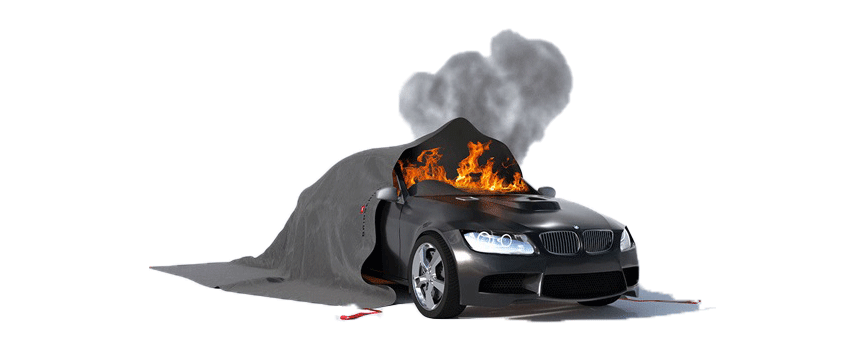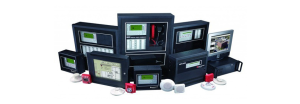fire blanket
The history of fire extinguishing fire blankets
The principle of suffocating fire with heavy materials (blankets, coats, carpets, etc.) dates back to the early 20th century. Just as portable chemical fire extinguishers were developed and widely used, fire blankets were also more formal.
In the 20th century, fire blankets were made of leather or wool (naturally low flammability and flame spread) and then asbestos. In the 1960s, the first modern fiberglass blankets were introduced, and current fire blankets are based on advanced versions.
standards
Unlike extinguishers, which first had manufacturing standards from 1948 onwards, fire blankets did not; There was no testing of fire blankets as a final product to put out different types of fires, so some blankets failed in use.
In 1985, BS6575 provided manufacturing and testing requirements for light and heavy fire blankets, together with Kitemarking, to ensure proper product performance in general.
In 1997, a European standard, BS EN 1869, was introduced in England, which covered the type of light blankets. (Heavy blankets not in commercial general firefighting were covered by BS 7944:1999) and are still valid today.
Use fire blanket
One of the most important advantages of the fire blanket is its use in controlling fires that may partially occur in the house and kitchen. Cooking fires often start with a small amount of fat in a container such as a pan or pot. Due to the cost of cleaning up after putting out a fire, people are often reluctant to put out a fire with a fire extinguisher. The use of a fire blanket is usually suitable for the elderly and children who have the ability to carry heavy fire extinguishers. Another of its most important advantages is the lack of need to clean the environment after extinguishing operations, and its availability prevents the fire from spreading and becoming uncontrollable.
One way to put out a cooking fire is to put a lid on the fire. This, if done correctly, will smother the fire. But it may be dangerous for you due to lack of adequate coverage. As a result, using a fire blanket reduces this risk. To use this blanket, we act as follows.
- If possible, turn off the heat source.
- A quality fire blanket has straps that help you fully enclose your hands for fire protection.
- You must quickly put the fire blanket on the fire without throwing it or igniting it.
- Hold the blanket over the fire until you are sure the fire is out.
A fire blanket is a safety device designed to extinguish and destroy a fire at its starting point.
Fire blankets consist of fire-resistant sheets that are placed over a fire to smother it.
Maintenance method
Again, unlike other extinguishers, fire blankets have never had formal maintenance periods, leading to blankets that are over 40 years old in some locations.
In May 2016, the Fire Industry Association introduced a code of practice based on the BS EN 1869 standard. which provides a standard set of maintenance operations and fire blanket replacement areas.

“Fake” fire blankets
In recent years, the market has been flooded with imported fire blankets that are often sold at low cost, and are not made of the proper base materials that will destroy in a fire after use. Often the instructions on the cover are misspelled and the actual blanket has no manufacturer’s label, the outer packaging of this type of blanket includes the wrong standard number.
To ensure your fire blankets are safe, you should only use blankets with the British Standard Kitemark in accordance with BS EN1869.
In 2014, the Dutch Food and Consumer Product Safety Authority carried out highly controversial tests on fire blankets that were reported by British manufacturers as not complying with the BS EN 1869 test method and produced abnormal results for fake blankets. Subsequent audits and BSI tests have confirmed that true compliant fire blankets remain suitable for Class F fires, but note the limitations in size, depth and volume. For any risk greater than ovens capable of having a small pan of cooking oil with an F rating. Extinguisher or static wet chemical system, water mist or ABF agent is essential.
Fire blankets work on the two principles of suffocating the fire and eliminating the oxygen agent. To do this effectively, they must themselves be non-flammable and prevent the transfer of heat and oxygen as much as possible. A modern commercial fire blanket contains a layer of fiberglass to achieve this goal, and the blanket is designed to prevent the fiberglass from coming into contact with the skin. The fire blanket should be installed on the wall near (but not directly) the area where it may be needed.
For example, NFPA codes and standards stipulate that fire extinguishers should be placed approximately 10 meters from cooking equipment, and it is better to place a fire blanket within this range. A fire blanket usually has a protective cover that is clearly visible and shows the user how to remove the blanket.
Benefits of fire blankets
They can be used for personal protection.
If your hair or clothes catch fire, wrapping them in a fire blanket can be an important part of the “stop, drop and roll” technique taught to minimize burns and injuries.
According to the NFPA, blankets are especially useful if the person involved is unable to move quickly due to age, medical conditions, or physical limitations. In a similar situation, discharging a chemical fire extinguisher around a person’s face can cause serious lung irritation from smoke inhalation.
If the fire is out of control and you are surrounded by flames, or if you have to evacuate areas close to the flames, a fire protection such as a fire blanket may protect you and those you are helping. slow
Using fire blankets in cooking
Cooking fires often start with a small amount of fat in a container such as a pan or pot. Because of the cost of cleanup, people are often reluctant to put out fires with fire extinguishers, and Class K fire extinguishers in particular are required for fires with combustible cooking materials (vegetable or animal oils and fats).
One way to put out a cooking fire is to put a lid on the fire. This, if done correctly, will smother the fire. But it may be dangerous for you due to lack of adequate coverage. As a result, using a fire blanket reduces this risk. To use this blanket, we act as follows.
If possible, turn off the heat source. A quality fire blanket has straps that help you fully enclose your hands to protect the fire. You must quickly put the fire blanket on the fire without throwing it or igniting it. Hold the blanket over the fire until you are sure the fire is out.
Who cares about the fire blanket?
People for whom it is not possible to use fire extinguishers, using a fire blanket is a suitable option. Some people may not be able to move fire extinguishers due to their small size. Considering that fire blankets are very light, moving them does not take much energy from people.
In addition, some people are worried about the consequences of using fire extinguishers. Also, they may not know which type of capsule to use in which fires. However, if the fire is small enough, using a fire blanket may be an easier decision.
Disadvantages and advantages of fire blankets
They are disposable
Fire extinguishers must be replaced or recharged after each use, while fire blankets must always be replaced after any use on a fire, even if they appear to be intact.
Old fire blankets may contain asbestos
The EPA instituted a partial ban on asbestos-containing products in 1989 because of the serious risks of lung disease associated with the material. Asbestos was very common in fire blankets before that time. If you have old fire blankets in your home or business that you suspect may contain asbestos, contact an asbestos removal professional and stop using them.
Fire blankets bring you closer to the fire
The correct technique for using a fire blanket requires that you place it correctly on the fire. If the flames are above the source or wide, a
This may be difficult or impossible to do. Therefore, it is not recommended to use fire blankets in large fires.
The use of fire blankets requires a little training
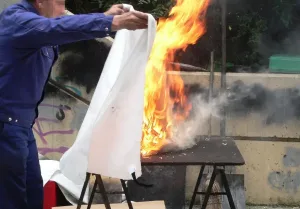
Without proper training, the fear of approaching the fire will cause you to drop or throw the blanket. This can make things worse by spreading flammable liquids or starting a fire. If you can’t wrap your hands around the corners of the blanket, you could burn yourself. For all these reasons, the use of fire blankets should include how and when to use them, just like fire extinguishers.
Fire blankets and fire extinguishers each play a role in fire safety
Fire extinguishers are required for commercial spaces and are highly recommended for all homes. They can prevent or minimize damage before the fire department arrives and often extinguish fires in their early stages. At the same time, the use of a fire blanket is also very effective in small fires. To read about the types of fire extinguishers, refer to the types of fire extinguishers.
A fire blanket can be effective in putting out a fire without having to clear the area. These blankets are very effective in small fires such as cooking fires. Fire blankets are a good idea for kitchens and areas where containers may catch fire. Also, if you have elderly or disabled people in your home or workplace who are not able to carry and use a fire extinguisher, the presence of a fire blanket can provide relative safety for that place.
Types of fire blankets
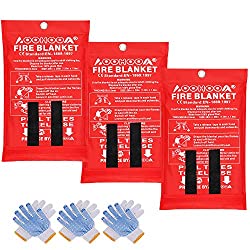
In this article, we examine the types of fire blankets and the advantages and disadvantages of each of them. Considering that most of the fires in houses happen in the kitchens and the use of fire extinguishers is not possible for all residents of the house, therefore, the presence of a fire blanket in the house due to its very easy use makes it possible to avoid injury. to prevent serious possible fire in the kitchen. In this article, we describe 5 types of fire blankets and mention the advantages and disadvantages of each.
Types of fire blankets are:
- JJ Care fire blanket
- DIBBATU FIRE FIRE BLANKET
- AOOHOOA FIRE BLANKET
- Tonyko fiberglass fire blanket
- Inf-wayare fire blanket
JJ Care fire blanket
JJ Care is one of the most reliable types of fire blankets. These blankets comply with the EN-1869-1997 standard for extinguishing cooking fires. These blankets can contain and extinguish fires up to 1076 degrees Fahrenheit (580 degrees Celsius). This package includes four 39″ x 39″ (1 square meter) safety blankets, plus four hooks to hang the blankets.
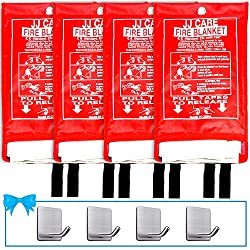
Benefits of JJ Care fire blanket
This package includes 4 separate blankets at a reasonable price. As a result, it is very economical. It also includes 4 separate blankets that can be used in different places such as kitchen, bedroom and car. The hooks in each package make it easy to place the blanket anywhere you want and hang it up.
Disadvantages of JJ Care fire blanket
They are small in size. As a result, they cannot be used for larger fires. Also, they don’t have fiberglass gloves, which we explained the advantages of these gloves in fire blanket.
DIBBATU FIRE FIRE BLANKET
DIBBATU fire blanket is a 39 x 39 inch (1 square meter) blanket designed with fiberglass fabric. This blanket is suitable for fires up to 1076 degrees Fahrenheit (ie 580 degrees Celsius). As a result, this blanket can be effective for many kitchen fires. This blanket is used as a multipurpose blanket. This means that this blanket can be used not only in the kitchen, but also next to the fireplace, outdoor cooking, in the car or garage, and when traveling due to its very light weight.
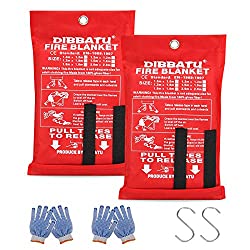
Advantages of DIBBATU fire blanket
This product comes in a pack of 2. As a result, it can be used in two different places. In addition, because these blankets are disposable, having a replacement blanket as a spare blanket is also an ideal option.
These blankets come with free gloves. These gloves prevent skin damage when used.
Disadvantages of DIBBATU fire blanket
They have only one fixed size and no hook for hanging.
AOOHOOA FIRE BLANKET
This package contains 3 fire blankets, each measuring 39 x 39 inches (1 square meter). These blankets can be used on fires up to 1076 degrees Fahrenheit (580 degrees Celsius), which is the legal standard for all types of fire blankets.
Benefits of AOOHOOA fire blanket
This product includes three separate blankets, which is better than the previous options. The third blanket can be used in the car or garage.
It has separate gloves to protect the skin from fiberglass.
Disadvantages of AOOHOOA fire blanket
Gloves are for fiberglass only, not for firefighting. Also, there is no hook in this package to hang the crane.
Tonyko fiberglass fire blanket
Tunico is one of the most popular types of fire blankets. Because it allows buyers to choose the size they want. These blankets can be used on fires up to 1076 degrees Fahrenheit (580 degrees Celsius), which is the legal standard for fire blankets.
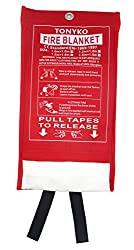
Advantages of Tonyko fiberglass fire blanket
Allows consumers to choose the size they want. As a result, you can choose from 5 sizes from 39×39 inches (1 square meter) to 78×78 inches (2 square meters). They offer an option of larger blankets for those looking for a large fire blanket.
Disadvantages of Tonyko fiberglass fire blanket
There is only one blanket in the package and no gifts such as hooks or gloves for using fiberglass.
Inf-wayare fire blanket
The Inf-wayare fire blanket is the latest model of fire blankets that meet our personal criteria. This blanket is made of fiberglass fabric and comes in different sizes. This blanket can be used in a fire of 1076 degrees Fahrenheit (580 degrees Celsius) and can be hung in a convenient place in the kitchen. They all have features we love!
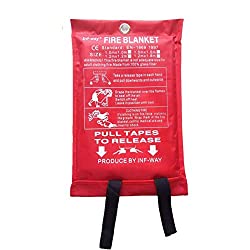
Advantages of Inf-wayare fireproof blanket
Like the Tonkyo fire blanket, consumers are allowed to select their size at checkout. They offer sizes from 39 x 39 inches (1 square meter) to 71 x 71 inches (1.8 square meters).
Disadvantages of Inf-wayare fire blanket
When you buy this product, you only get a blanket and there are no options such as hooks or gloves in the packaging of this product. If you want to buy this package, you need to buy special hooks to hang this product, which will increase the overall cost.
How to choose the right blanket from a variety of fire blankets
Now that we have described the types of fireproof blankets, we will describe how to choose from the available options so that you can choose the best option.
Some of the main features that we personally need to look for when buying a fire blanket are:
The right size to suit our needs
Use of fiberglass material in fabric
Complies with EN-1869-1997 standard for cooking fire i.e. 1076°F (580°C).
In this article, we presented fireproof blankets that have the following conditions.
1) We have described the different sizes of fire blankets
Fire blankets can come in different sizes. Consumers who want maximum flexibility in sizing may choose the Tonkyo blanket, which is available in 5 sizes.
Smaller blankets are designed to cover the stove. Their size is usually 39 square inches (1 meter by 1 meter), which is enough to fit on a small gas stove. 39 x 39 inches is the standard size we can use for a fire blanket in the kitchen.
Larger safety blankets have other benefits. For example, they can cover some large items or they can completely wrap around a person whose clothes are on fire. The biggest advantage of the Tonkyo blanket was that it offered a 79 x 79 inch (2 square meter) blanket. The downside of larger blankets is that they can be a bit difficult to throw or place over a fire. Fortunately, the blankets are quite light.
2) We checked whether it is made of fiberglass material or not
Fire blankets are usually made of fiberglass cloth. Fiberglass fabric is soft and flexible and resistant to heat and fire. All fire blankets in this review are made of fiberglass material as this is the minimum standard for the products we have selected for ourselves.
The downside of fiberglass cloth is that fiberglass can damage your skin and clothes if you are not careful. Fiberglass contact with the skin causes itching. It is also very difficult to clean the carpet if the fiberglass comes into contact with it.
If you’re concerned about handling fiberglass, consider some brands, such as the DIBBATU fire blanket, which comes with a glove for minimal skin contact.
3) We checked the fire safety rating
All fireproof blankets offered for home kitchen are under safety standard EN-1869-1997. This standard ensures that the blankets are suitable for cooking fires up to 1076°F (580°C). All the blankets in this review met this standard at the time of research.
دیدگاه خود را با ما در میان بگذارید


